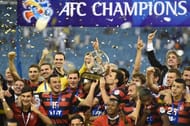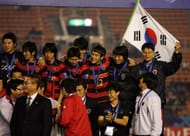Asian Champions League, the equivalent of UEFA Champions League, Copa Libertadores, CAF Champions League, OFC and CONCACAF, was founded in 1967 as Asian Champion Club Tournament.
Western Sydney Wanderers are the reigning champions of the AFC Champions League, and the most successful club of the tournament throughout its history has been Pohang Steelers (South Korea) with three titles to their name.
The Asian Champion Club Tournament (1967-1971)
The Asian Champion Club tournament was played in several different formats, with a knockout format in its maiden year, but operated for only four seasons before it was shut down in 1971 due to lack of interest and unprofessionalism both among the organisers as well as the participants.
The Mysore State team (now Karnataka State football team) has to be the most successful Indian team to have played in the Asian competition as they reached the semi-finals of the competition in 1969, only to lose to the ultimate winners Maccabi Tel Aviv 6-1.
The two most successful teams during this era came from Israel – Maccabi Tel Aviv (1969, 1971) and Hapoel Tel Aviv (1967). But in 1974, mainly due to political pressure, Israel was disallowed from playing in the tournament, following which they joined UEFA in 1994.
Asian Club Championship (1985-2002)
After a 14-year-long interlude, the competition was revived as Asian Club Championship in 1985 with Daewoo FC (now Busan IPark) winning the tournament in its season of inception, defeating Al-Ahli in the finals with an aggregate score of 3-1.
East Bengal FC was the most successful club in the qualifying stages of the first season of this edition of the tournament with a 100% win rate, scoring 20 goals in the five matches played in the Central Asia group. Despite impressing in the qualifiers, they failed to recreate the same form in the group stages of the competition, losing both their matches and in-turn failing to enter the knockout round (semi-finals) of the competition.
Two of the most successful teams during this edition of Asian Club Football competition were the Pohang Steelers (1996-97, 1997-98) and Al-Hilal FC (1991, 1999-2000), both with two titles each.
Asian Cup Winners’ Cup and Asian Super Cup
The Asian Football Confederation also introduced the Asian Cup Winners’ Cup in 1991 and Asian Super Cup in 1995. The former was played among winners of all the domestic leagues from countries associated with the AFC while the latter was a tournament between the winners of Asian Club Championship and Asian Cup Winners’ Cup.
The most successful teams in the Asian Cup Winners’ Cup are Yokohama F Marinos of Japan, who’ve won the cup twice (1991-92, 1992-93) and Al-Hilal of Saudi Arabia (1996-97, 2001-02). The Yokohama Flugels also won the cup once in 1994-95 and since they dissolved and then merged with the Yokohama Marinos in 1999, that honour is now shared between the two teams.
Al-Hilal FC (1997, 2000) and Suwon Samsung Bluewings (2001, 2002) are the most successful teams of the Asian Super Cup, with both the teams winning the cup on two occasions.
The AFC Champions League (Since 2002)
The AFC Champions League or the Asian Champions League was introduced in 2002, after combining the Asian Club Championship, Asian Cup Winners’ Cup and Asian Super Cup. In the first year, the winners of domestic leagues and cups of the member nations of Asian Football Confederation qualified for the qualifying rounds of the Champions League.
Qualifying teams were divided into east and west Asia (on a regional basis to reduce travel costs) and the top eight clubs from both the zones were required to qualify for the group stage of the competition. The first winners of the AFC Champions League were Al Ain FC of Saudi Arabia, who had defeated BEC Tero FC of Thailand in the final (2-1 on aggregate).
From the following year, the competition was held between 29 clubs from 14 countries identified by the AFC, one of which were the defending champions, who got a spot straight into the quarterfinals. The remaining 28 clubs were divided into seven groups of four teams which then competed in a double-round robin (home and away games) followed by the knockout rounds in which all the seven top clubs in their group competed along with the defending champions again in a two-legged format.
Saudi side Ittihad FC defeated the Seongnam Ilhwa Chunma FC 6-3 on aggregate in two rather exciting fixtures. Ittihad lost their home game 1-3 to the South Korean side, only to bounce back in an astounding fashion with five goals in the away fixture.
Although the tournament was still being criticised for lack of professionalism, on-field fights, lethargic administration and low prize money, Syria became a member of the AFC in 2005 and were followed by Australia in 2006.
AFC Cup (2004 Onwards)
AFC Cup was started with a vision for a competition between the ‘developing nations’ of Asia and was played among the teams which didn’t qualify for the AFC Champions League. The Cup wasn’t interlinked with the League until 2009 and both held competitions between different sets of teams altogether.
Since 2009, finalists of the AFC Cup are eligible to compete in the qualifying rounds of the League in the following season, while the worst performing teams of the league are relegated to play in the AFC Cup.
The most successful club of AFC Cup are Kuwait Sporting Club with three titles to their name. The most successful Indian clubs in the competition are Dempo and East Bengal FC, with the two teams reaching the semi-finals in 2008 and 2013, respectively.
Dempo lost to Lebanese club Safa 5-1 on aggregate to bow out of the tournament, while East Bengal lost to Al-Kuwait 7-2 on aggregate.
Updates to the format in 2009

In 2009, further updates to the format took place as now 32 teams received an entry into the competition if they passed the criteria set by the AFC Pro-League Committee, which included the league structure, marketability, financial status and the participants league standings as few pointers, among others. Teams from the strongest Asian domestic leagues would receive an automatic spot while teams from other national leagues which are eligible would then play in qualifying playoffs and will also be eligible to participate in the AFC Cup.
Single-match finals at a neutral venue were also introduced in this edition of the competition which was won for the third time by Pohang Steelers (South Korea) – making them the most successful club in the history of the competition -- defeating Ittihad FC 2-1.
The same year teams entering the group stages were also given a prize money depending on their performance and the final prize money was also significantly increased over the years, with the latest prize money being $1.5 million for the champion and half of that for the runners-up.
2009 onwards, the champions did not qualify for an automatic spot in the next year’s knockout rounds (as defending champions), rather they qualified for a spot in the FIFA Club World Cup.
In 2013, the confederation reverted back to a two-legged final and owing to the success of the format in the given year, it was followed again in 2014.
The 2014 champions and the first Australian club to win the Asian Champions League are the Western Sydney Wanderers.
Rising from fourteen member nations of the confederation to 46 in the present day, the AFC Asian Champions League has come a long way to becoming a professional league which holds the same respect as the rest of its counterparts around the globe.

